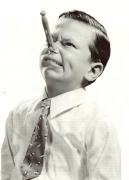
Originally Posted by
farscott

I am not sure I am following you. The larger the radius applied to the bottom of the firing pin stop, the higher on the hammer the firing pin stop impacts. That allows the hammer to experience more applied torque for the same given slide force (mass times acceleration). So providing a larger radius to the firing pin stop makes cocking the hammer easier. For the flat-bottom firing pin stop, the slide needs to provide more force to cock the hammer as the force is applied closer to the hammer's center of rotation. Another way to think about it is that there is a given amount of torque needed to cock the hammer, and there are several variables that can be changed to adjust that torque. One variable is where the torque is applied, another variable is slide acceleration, and a third is the mainspring spring constant. A fourth would be the recoil spring constant. There are other variables, including how the barrel bushing is fitted, but the four listed are the primary ones. The variable we are discussing is the torque. The initial reason for the radius was to make loading easier when starting with the hammer in the at rest position.
Since cartridges that have more recoil energy (same slide travel, so has to be more force, so more acceleration as slide mass is constant) apply more recoil acceleration to the slide, it makes sense to use a smaller radius on the firing pin stop. The same amount of torque is applied to cocking the hammer, but more of the slide's rearward travelling energy (force * distance) is needed to cock the hammer. That makes the gun's perceived recoil seem less as the slide is using more energy to cock the hammer than it would with the "standard".
It is also the reason why a flat-bottom stop should not be fitted on a 9x19 pistol as the amount of acceleration provided by the 9x19 round is already marginal for the 1911 design. My 9x23 gun also has a barrel fitted with a Kart 9x19 barrel. To use the same firing pin stop and mainspring from the 9x23 with the 9x19 barrel, the recoil spring is a 9# unit and the gun is hard chromed to decrease frictional losses. The 9x23 barrel uses a 18# recoil spring. While perceived recoil with the 9x23 is more than the 9x19 barrel, most shooters feel it is similar to a standard .45 ACP, even though the 9x23 energy is much more.



 Reply With Quote
Reply With Quote



